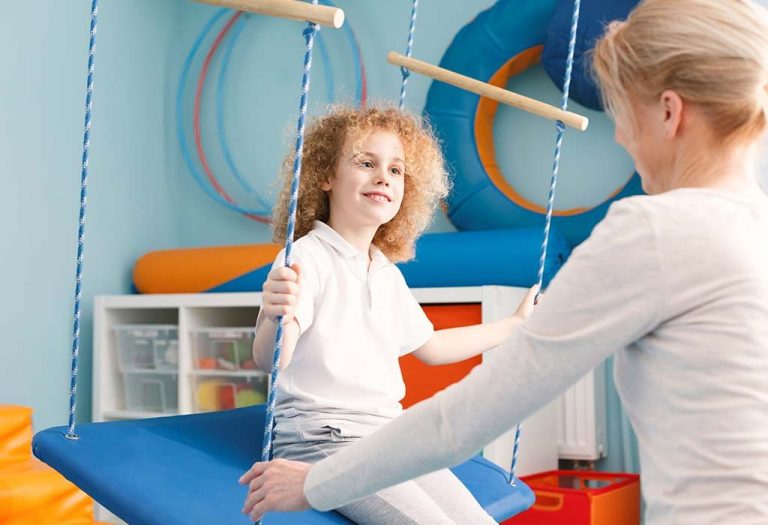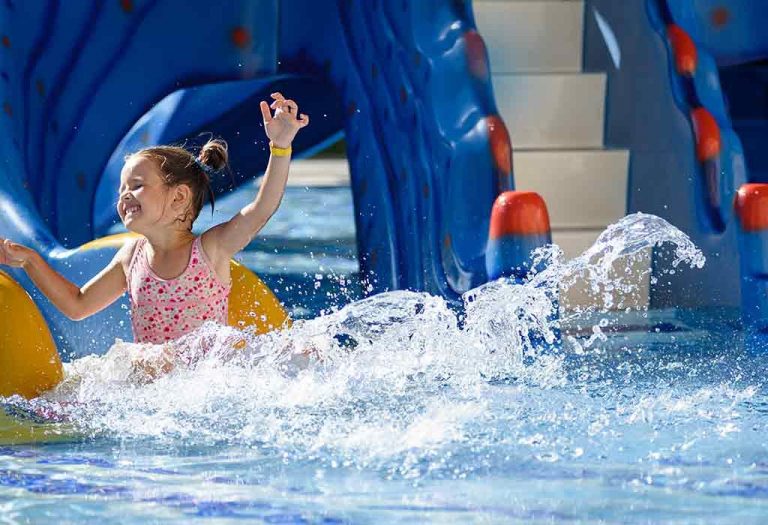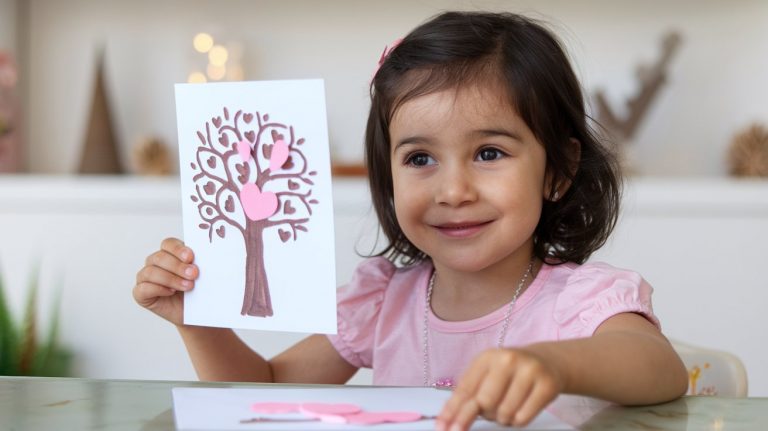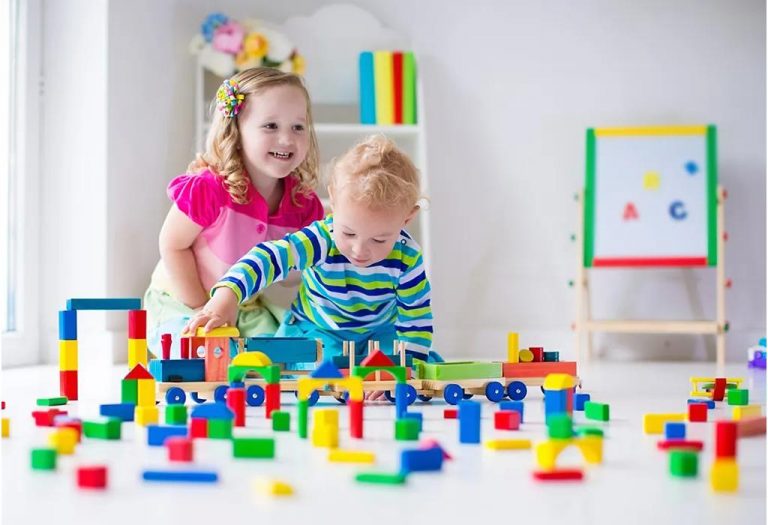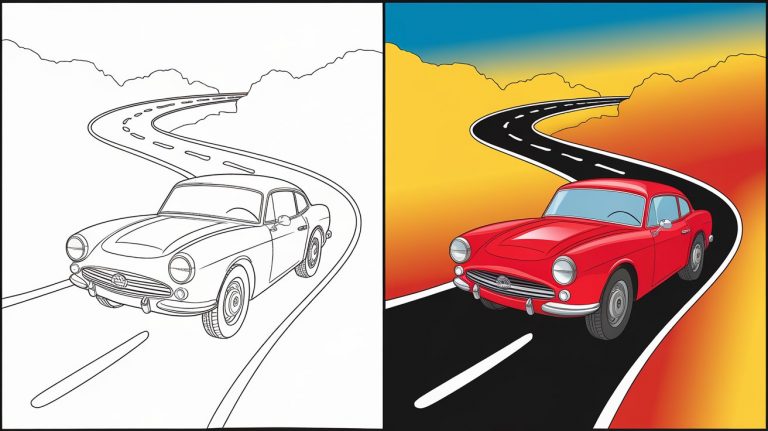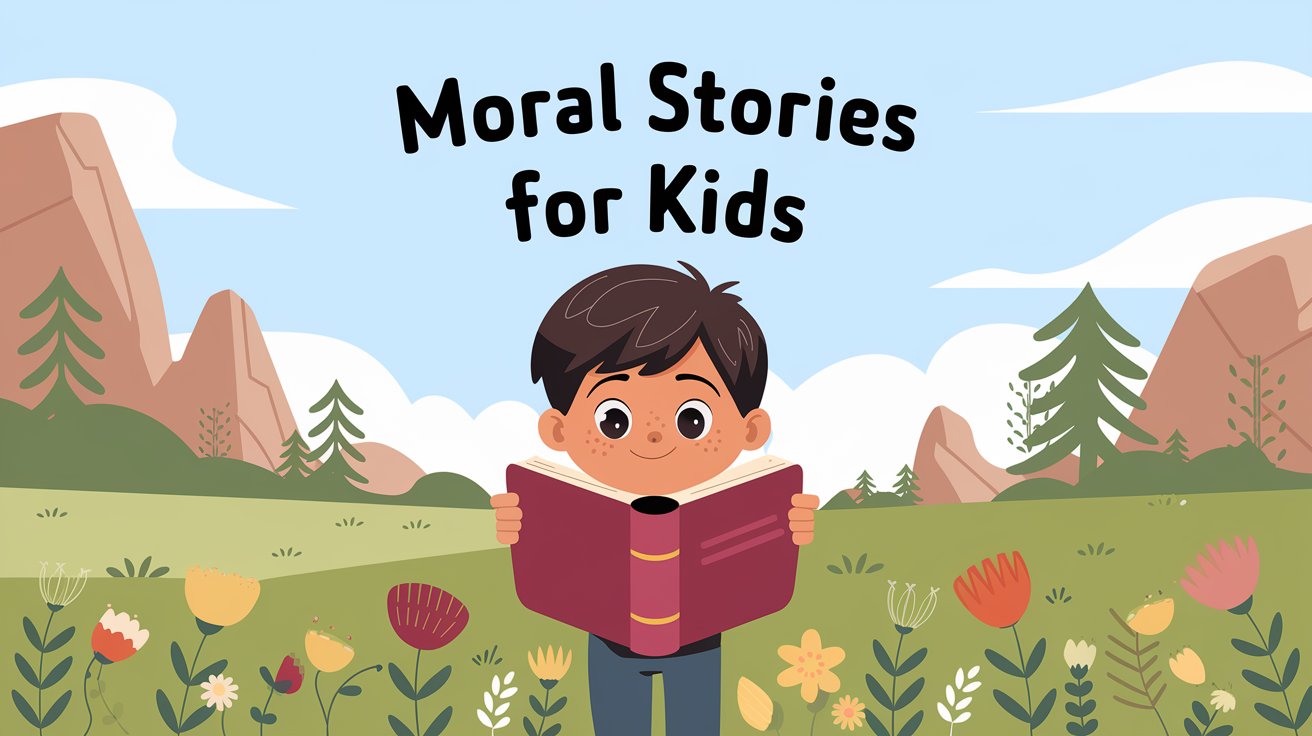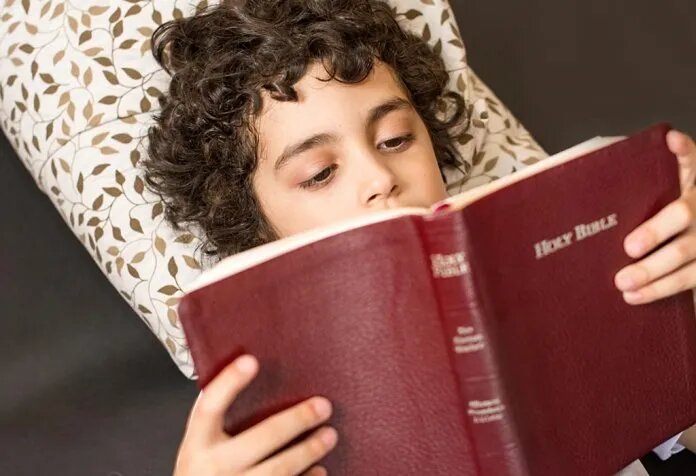Sensory Swing for Kids – Types and Benefits
Sensory swings have been growing in popularity for the past few years, and it’s easy to see why. These swings offer more than just a fun activity; they serve as powerful tools that support and encourage essential developmental skills in children. Sensory swings provide children with a safe space to explore movement, which helps with balance, coordination, and body awareness. For children with specific sensory needs, such as those with ADHD, Sensory Processing Disorder (SPD), or autism, these swings can be incredibly beneficial. The gentle motion helps them regulate their emotions, calm their nervous system, and improve their sensory processing skills. Sensory swings can also create a calming effect, which is essential for reducing anxiety and boosting concentration.
What Is a Sensory Swing?
There are so many sensory swings out there, in different shapes and sizes, but they all serve one purpose. Sensory swings are used to help children feel safe and soothe their overly stimulated senses. Occupational therapists have been using sensory swings for a long time to help children with their senses. Swings that can move in specific rotations and directions can help decrease a lot of sensory-related behaviors, like body awareness, poor attention, and motor planning. Sensory swings are not just swings for autistic children or children with other sensory needs but it can be used by any child who needs to improve their senses.
Benefits of Sensory Swings
There are so many benefits that come with sensory swings including:
- Vestibular sense informs safety, body awareness, balance, muscle tone, and coordination, and different types of sensory swings can be used to target specific vestibular receptors through their pattern of movement.
- Swings can challenge balance, core strength, motor skills, and righting reactions in different ways, depending on the type of swing you choose.
- Using sensory swings through various therapeutic activities can help build these skills in children in very fun and relaxing ways. For example, a platform-style swing challenges balance while in a seated position. The trapeze-type swing can help improve the upper body strength and by adding a crash mat, you can challenge timing skills. Throwing items into the target while swinging can help improve timing, righting reactions, and visual-motor.
- There are various other swings that allow for combined vestibular input.
- 15 minutes of swinging can have good effects on the brain that can last up to 6-8 hours. In order to understand how to monitor and include spinning your children in controlled doses, you can consult your occupational therapist.
- Sensory swings allow a lot of movement options that may be required for children who over-respond or under-respond to vestibular input. Depending on the type of sensory swing you choose, the ability to meet individualized movements may vary; for example, rotary swinging and upside-down movements are very intense. Bouncing, jumping, and other such linear movements are some of the most tolerated vestibular inputs. Rhythmic, predictable swinging can promote organization and calm, while arrhythmic, unpredictable swinging can be alerting.
- The vestibular system and the visual system are closely linked, so defects or improvements in the processing are often seen in both these systems. Sensory swings can help develop and challenge the functional use of vision by giving children the option of eliminating visual feedback and completely immerse in the swing or use the visual system to see while moving. The pod swing is the perfect sensory swing for this since it can be used without or with vision.
- These swings can help support sensory diet planning in children for self-regulation purposes. Whether the intention is to alert and stimulate or calm and reorganize, there is always a sensory swing out there that can help meet the needs of your child.
- Sensory swings can also be used in group activities, helping children learn how to take turns, communicate, and share space with others. This can be especially valuable for kids who may struggle with social interactions, as it creates opportunities to build social skills in a structured, engaging way.
How to Use Sensory Swing Safely
You would have seen ads on social media that claim that sensory swings can instantly calm children and eliminate their tantrums. This is not true at all since children who are sensitive to movement will freak out when they sit on the sensory swing.
- Sensory sensitivity is something the parent has to work at overcoming.
- Never force your children to get on the swing since this may make the sensory processing worse, leaving them more fearful.
- Also, be careful when spinning the child in the swing because this is a very strong sensory input. Some children may throw up, even if they love spinning, which means that their vestibular system has overloaded.
Therefore, you should either avoid spinning your child in the swing, letting them do it on their own or spin them only for a few seconds. After that in order to balance their system out, spin them in the other direction.
Types of Sensory Swings for Children
Here are a few outdoor and indoor therapy swings you could consider buying:
1. Versatile Stretchy Swing
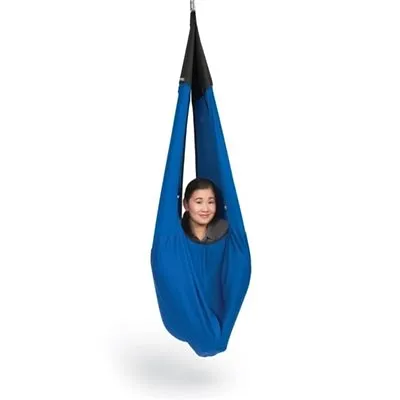
Image Credit: Pinterest
If your child loves big hugs, tight clothes, and crawling into small spaces, then this is the perfect swing. This type of swing has a stretchy fabric that will help envelope the child. Your child can not only swing in it, but he/she will also get a lot of vestibular sensations and calming proprioceptive sensations from the fabric pushing against the child’s body. The versatile stretchy swing gives the child a place to retreat and escape overwhelming stimuli around like bright lights. In the swing, the child can sit, lay down, and stand. They will also be able to bunch it up under their arms and hand from it.
2. Skateboard Swing
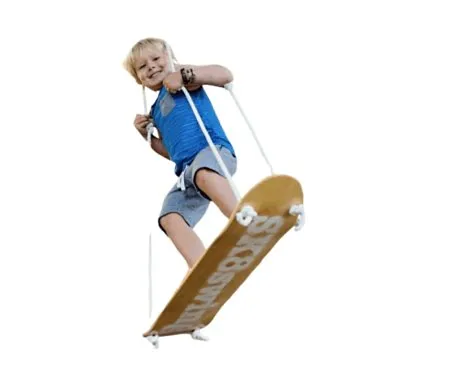
Image Credit: Pinterest
The Skateboard Swing is a great outdoor option that you can hang on a swing set of a tree. This type of swing will provide challenges that can improve the child’s balance, coordination, motor planning, and core strength. It is suggested for children who are three years old or above. This swing set can help your child pretend that they are blasting off to space or surfing on a huge wave on this fun and easy-to-use sensory swing set!
3. Pod Swing
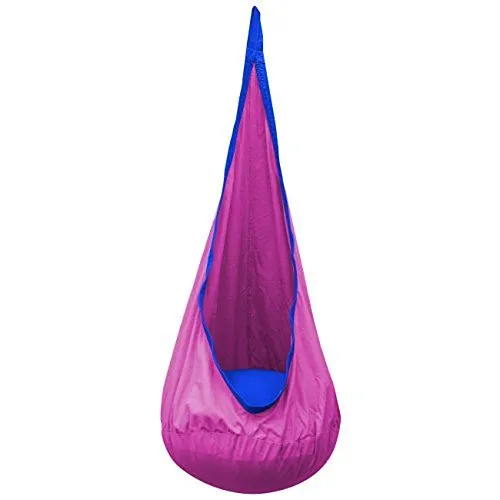
Image Credit: Pinterest
The Pod swing is a very fun place that kids would love climbing into. Many children also use this as a hideaway when they get overstimulated or when they need a break. Kids can be pushed in this swing or spin in it but your child will not be able to lay down in the swing. Another benefit of getting a pod swing is that it can increase interaction by inspiring the imagination of your child. For example, if you get a blue pod swing, your children can imagine climbing aboard a big blue whaleboat and are on an epic voyage, exploring the seas and fighting dangerous sea creatures. The pod swing can be kept indoors or outdoors.
4. Mesh Swing
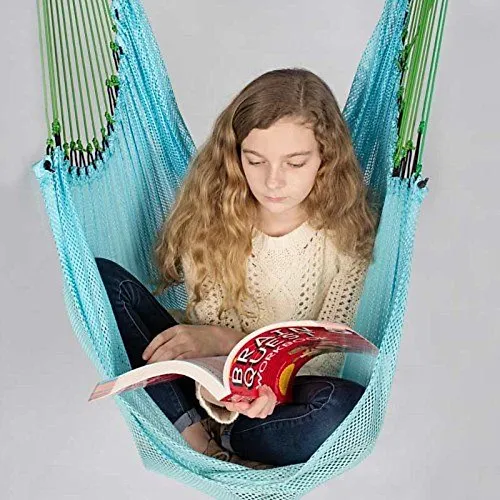
Image Credit: Pinterest
The Mesh swing or the net-style swing provides the child with a lot of options. You can either spread the mesh out a little, so it sits like a seat or spread it out completely, so your child can lie down on it. The swing is great for children who are above three years of age.
5. Flying Saucer Swing
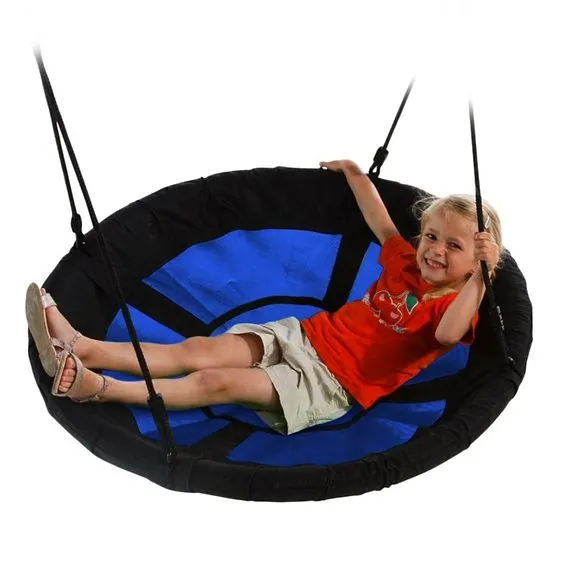
Image Credit: Pinterest
The large saucer swing has started becoming one of the favorites in many homes. This is because children find this one really fun since they can lie down, sit, or stand on the swing, taking in a lot of sensory input. This swing can work indoors but it is usually designed to hang from a tree.
6. Hammock Swing
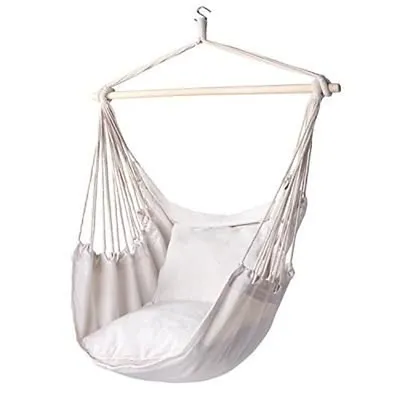
Image Credit: Pinterest
The hammock swing is an affordable indoor and outdoor option that your kid would find very relaxing. This swing is perfect for children who would want to stay connected to their surroundings while sitting in the swing but would still wish for some security, which the swing’s sides will provide. It is perfect for kids who like to relax with gentle sways.
7. Log Swing
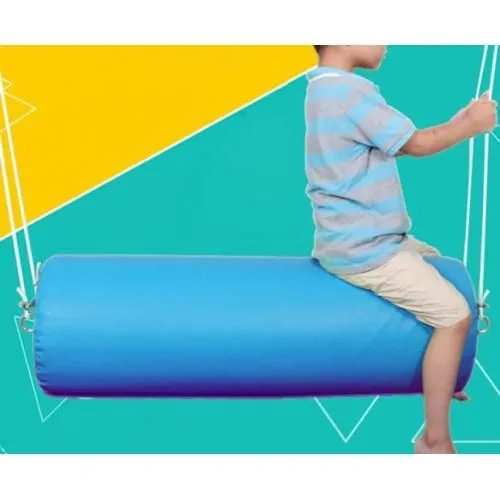
Image Credit: Pinterest
The Log/Bolster swing is a popular occupational therapy swing. This swing is a bit challenging and you can always encourage your children to play on these. On the floor under the swing, you can place thick mats since it challenges the core strength and motor planning in children. To help the children climb on the swing, you could use a step stool and ask the child to either lie down on their stomach and wrap their body around the log or normally sit at one end and hold onto the ropes of the swing. You can then push them back and forth.
8. Platform Swing
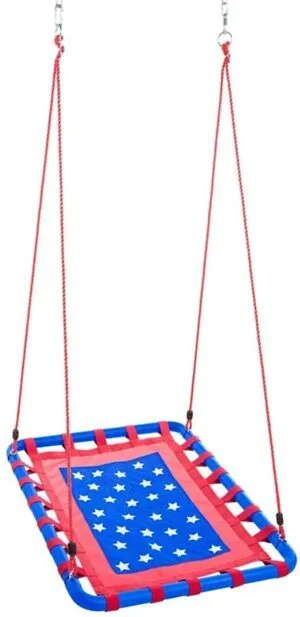
Image Credit: Pinterest
The platform swing can be seen in every occupational therapy clinic. This is because the presence of the firm support underneath allows little children to comfortably lie down on their tummy. Swinging in a back and forth motion while the kid is in this position is a sensory integration treatment technique. The platform swing can be used to hold multiple children based on its size and is mostly suggested for children that are five years old and above.
Place some stuffed animals or bean bags on the floor beneath them and encourage kids to lay down on the platform on their bellies. Encourage them to reach over and grab the stuffed animals when they swing past and then throw it in a target while they remain in this position. This encourages various processing skills in children. It can also be incredibly calming to children that are often very active. However, never force them to do this since some kids may feel more secure sitting on the platform initially and they can slowly work up to lying down.
9. Disc Swing
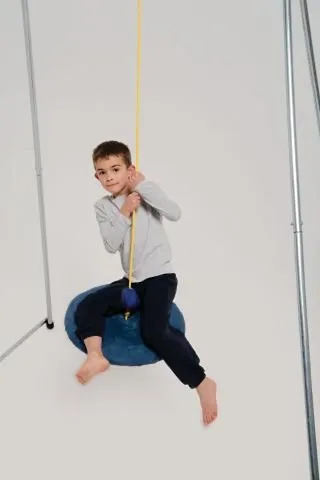
Image Credit: Pinterest
The Disc swing is an amazing option for children who are three years old and above since it gives them a lot of challenges and helps them with their motor planning, core strength, and grip. This can be hung on any tree or an outdoor swing and with some additional hardware, it can even be hung inside your home too. If your child, however, is sensitive to movement, then this swing would not be a good option; for children who love movement and are constantly looking for adventures, this type of swing is perfect.
FAQs
1. How can I use a sensory swing to help my child with spatial awareness?
A sensory swing can be used to enhance spatial awareness by creating activities that challenge your child’s ability to judge distance, direction, and movement. For example, placing targets around the swing and encouraging your child to throw or reach for objects while swinging can help them practice hand-eye coordination and spatial perception. Additionally, using different swing positions, such as lying on the stomach or back, can stimulate spatial understanding from various perspectives.
2. How can sensory swings help with my child’s emotional regulation?
Sensory swings can be highly effective for supporting emotional regulation in children who struggle with managing big emotions. The rhythmic, soothing motion of the swing activates the vestibular system, which has a calming effect on the brain. Using a swing during moments of stress or overstimulation can help your child feel more grounded and centered. Incorporating the swing into a sensory break routine can provide a safe way for them to release pent-up energy and regain emotional balance.
Sensory swings for kids are not just a fun addition to your home but are incredibly functional. After consulting with your kid’s occupational therapist, you can select a sensory swing that will perfectly meet the individual needs of your child.
References/Resources:
1. Murdock. L, Dantzler. J, Walker. A, Wood. L; The Effect of a Platform Swing on the Independent Work Behaviors of Children With Autism Spectrum Disorders (Focus on Autism and Other Developmental Disabilities); ResearchGate; https://www.researchgate.net/publication/275441581_The_Effect_of_a_Platform_Swing_on_the_Independent_Work_Behaviors_of_Children_With_Autism_Spectrum_Disorders; February 2013
2. Thukral. K, Sharma. R, Kalra. C, Kaushik. P; To Study the Comparative Effect of Disc Swing And Stretch Swing On Occupational Performance In ASD Children; Journal of Advanced Zoology; https://jazindia.com/index.php/jaz/article/view/4804
3. Deng. J, Lei. T, Du. X; Effects of sensory integration training on balance function and executive function in children with autism spectrum disorder: evidence from Footscan and fNIRS (Frontiers in Psychology); National Library of Medicine; https://pmc.ncbi.nlm.nih.gov/articles/PMC10631781/; October 2023
4. Pfeiffer. B, Koenig. K, Kinnealey. M, Sheppard. M, Henderson. L; Effectiveness of Sensory Integration Interventions in Children With Autism Spectrum Disorders: A Pilot Study (American Occupational Therapy Association); National Library of Medicine; https://pmc.ncbi.nlm.nih.gov/articles/PMC3708964/; July 2013
5. Camarata. S, Miller. L, Wallace. M; Evaluating Sensory Integration/Sensory Processing Treatment: Issues and Analysis (Frontiers in Integrative Neuroscience); Frontiers; https://www.frontiersin.org/journals/integrative-neuroscience/articles/10.3389/fnint.2020.556660/full; November 2020
6. Gallaher. K; Does vestibular sensory stimulation, in the form of slow, linear swinging, change the modes of communication among children with autism?; James Madison University; https://commons.lib.jmu.edu/cgi/viewcontent.cgi?article=1073&context=honors201019
7. Omairi. C, Mailloux. Z, Antoniuk. S, Schaaf. R; Occupational Therapy Using Ayres Sensory Integration®: A Randomized Controlled Trial in Brazil; American Journal of Occupational Therapy; https://research.aota.org/ajot/article/76/4/7604205160/23325/Occupational-Therapy-Using-Ayres-Sensory; July 2022
Also Read:
Sensory Activities for Children
DIY Sensory Board Ideas for Kids
Five Senses Activities for Children
Building a Sensory Room on a Budget for Your Kid
Was This Article Helpful?
Parenting is a huge responsibility, for you as a caregiver, but also for us as a parenting content platform. We understand that and take our responsibility of creating credible content seriously. FirstCry Parenting articles are written and published only after extensive research using factually sound references to deliver quality content that is accurate, validated by experts, and completely reliable. To understand how we go about creating content that is credible, read our editorial policy here.





